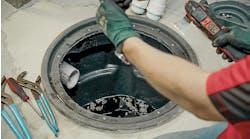WHILE ON MY way to check an antique shower valve, the homeowner remarked, “Hang on a minute, the first floor toilet is running — again.” The exasperation in her voice was palpable. So, we detoured to the powder room under the staircase. As she removed the tank’s lid, I could immediately see why the ballcock valve was making an audible trickling noise: A steady stream of water was falling — dead center— down the overflow tube. This is the kind of noise that drives homeowners to distraction while wasting hundreds, if not thousands, of gallons of water per month.
My offer to fix the problem was rebuffed as she remarked, “I’ve had four other plumbers try to fix this problem and not one of them succeeded.”
While she held the lid, I gently bent the copper after-fill tube in order to raise it up above the tank’s water level. The siphonage immediately stopped. End of problem.
I noticed another potential problem and asked her if they ever needed to jiggle the handle in order to make the toilet stop running full tilt?
“How did you know that?” she asked. “You’ve never been here before.”
Well, it’s not that I’m Sherlock Holmes, but I’ve been around the block more than a few times and it seems like everything I learned about repairing water closets was in the School of Hard Knocks. Callbacks are a stern teacher!
There really wasn’t any mystery about why their water closet would run after flushing: The chain to the flapper was in the farthest hole from the handle and it was too long. As the handle is pushed down, the flapper rises up to a vertical position and remains there until the water level falls, and having the chain hooked in that last hole allows it to droop over the flapper’s leading edge as soon as the handle is released.
As a result, the flapper is sometimes snagged and remains suspended above the flush valve while copious amounts of water are wasted until someone jiggles the handle. Proper settings for a flapper’s chain will see its S-hook in the hole closest to the handle with very slight slack in the chain. When flushed, the chain will fall behind the flapper where it can’t cause problems. Pinch the ends closed on the S-hook and test the operation before turning the water back on.
Making sure that the handle can’t rotate counter-clockwise within the tank’s opening and that the handle’s arm won’t smack the china lid during use will help ensure flawless operation.
Tank balls with lift-wires can be a challenge too. As an apprentice, I was handed a set of lift-wires and a tank ball for installation in a customer’s water closet. Paul, the mechanic who handed me the parts, had already removed the old pieces and discarded them. It was obvious the straight copper rod with the threaded end was intended for the tank ball’s top, but what to do with those two loops? They reminded me of a universal joint, so I took my pliers and opened one loop, inserted it through the second loop and pinched the opening shut. The handle’s arm had a series of holes along its span and I bent the upper lift wire to fit through the one at the end.
Everything was fine until I filled the tank with water and tested the operation. I looked up to see Paul just about doubled over as he tried to contain his laughter; then he undid my masterpiece to show me how the two lift-wires fit together: the lower lift-wire sliding through the upper lift-wire’s loop, which allows the handle arm to reset without affecting the tank ball’s operation.
The tank ball and lower lift-wire should be centered over the flush valve’s opening. It’s often a good idea to use a scrap piece of grit cloth to dress a brass flush valve’s seat, which will remove any deposits left behind from the old tank ball or hard-water minerals. Any defects in the brass surface become immediately apparent along the now shiny rim where the new tank ball will be expected to provide a watertight seal.
The upper lift-wire should extend vertically, or nearly so, to where it intersects with the handle’s arm. Occasionally, it’s necessary to bend the arm towards the front of the tank to provide clearance and keep the two lift-wires separated during the flush.
The lower lift-wire should sit somewhat above the upper lift-wire’s bottom loop. This gives the tank ball some leeway for sagging, which it will do over time. The upper lift-wire’s loop should not come to rest on the guide arm but stop just slightly above it. If the upper lift-wire rests on the guide arm, it can push the lower lift-wire off center, causing the tank ball to catch on the flush valve’s rim or else pinch the lower lift-wire in the guide arm, which can leave it suspended in mid-air while the water closet runs full-tilt.
Dave Yates owns F.W. Behler, a contracting company in York, Pa. He can be reached by phone at 717/843-4920 or by e-mail at [email protected].
All Dave Yates material on this website is protected by Copyright 2008. Any reuse of this material (print or electronic) must first have the expressed written permission of Dave Yates. Please contact via email at: [email protected]

